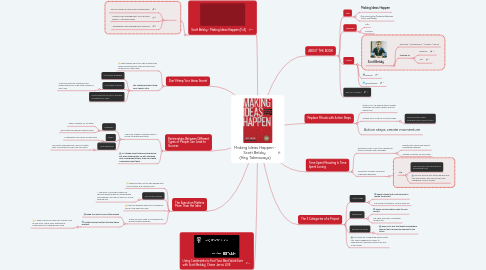
1. Scott Belsky - Making Ideas Happen (Full)
1.1. See Also
1.1.1. How to Create an Idea-Driven Organization
1.1.2. Creative Task Management: From Brilliant Ideas to Actionable Tasks
1.1.3. MindMeister: Idea Management Software
2. Using Constraints to Fuel Your Best Work Ever with Scott Belsky | Chase Jarvis LIVE
3. The Execution Matters More Than the Idea
3.1. Ideas provide us with high energy and commitment, but it doesn't last
3.2. The Project Plateau
3.2.1. = The point in a project where we become demotivated or disinterested and abandon our idea in favor of a new, exciting one
3.3. Even the greatest idea can't change the world if the execution fails
3.4. That's why you need to counteract the project plateau problem
3.4.1. Make the most of your initial energy
3.4.2. Adopt working routines that are highly efficient
3.4.2.1. A fixed routine can help you sit down and do the work, rather than wasting the limited amount of energy you have
4. Partnerships Between Different Types of People Can Lead to Success
4.1. There are 3 types of people when it comes to realizing projects
4.1.1. Dreamers
4.1.1.1. Highly creative, full of ideas
4.1.1.2. Have difficulty seeing things through
4.1.2. Doers
4.1.2.1. Pragmatists who focus on execution
4.1.3. Incrementalists
4.1.3.1. Can switch between both roles, but often start more projects than they can finish
4.2. All 3 types have trouble working alone, but when they partner up with someone who complements them, they can create a winning project team
5. Don't Keep Your Ideas Secret
5.1. Many people have the urge to keep their ideas secret because they're scared that someone will steal them
5.2. But sharing and discussing your ideas is vital
5.2.1. It provides feedback
5.2.2. It provides criticism
5.2.2.1. It lets you discover problems and opportunities you may have missed on your own
5.2.3. It puts pressure on you to actually complete your idea
6. ABOUT THE BOOK
6.1. Title
6.1.1. Making Ideas Happen
6.1.2. Overcoming the Obstacles Between Vision and Reality
6.2. Published
6.2.1. 2012
6.2.2. Portfolio
6.3. Author
6.3.1. Scott Belsky
6.3.1.1. executive / entrepreneur / investor / author
6.3.1.2. Founder of
6.3.1.2.1. Behance
6.3.1.2.2. 99U
6.3.2. Website
6.3.3. @scottbelsky
6.4. Get it on Amazon
7. The 3 Categories of a Project
7.1. Action Steps
7.1.1. Specific tasks that must be done to realize the project
7.1.2. e.g. create illustrations, write outline etc.
7.2. References
7.2.1. Pieces of information useful to your project
7.2.2. e.g. sales forecasts, competitor analysis etc.
7.3. Backburner Items
7.3.1. Ideas or to-dos that aren't immediately relevant but can become relevant in the future
7.4. It's important to separate each project into these categories in order to separate the important things from the trivial things.
8. Replace Rituals with Action Steps
8.1. Rituals, such as weekly status update meetings, are often useless and just waste time
8.2. Instead, think in terms of action steps
8.2.1. Capture action steps whenever they come to mind
8.3. Action steps create momentum
9. Time Spent Reacting Is Time Spent Losing
9.1. We spend most of our time reacting to others' requests and messages
9.1.1. Reactionary workflows lead to squandered energy
9.1.2. Instead of acting, we only react
9.2. Successful projects require an organized approach
9.2.1. Tip
9.2.1.1. Use one hour every evening as 'processing time'
9.2.1.2. Use this time to sort every request and new information into one of the three categories of your project
